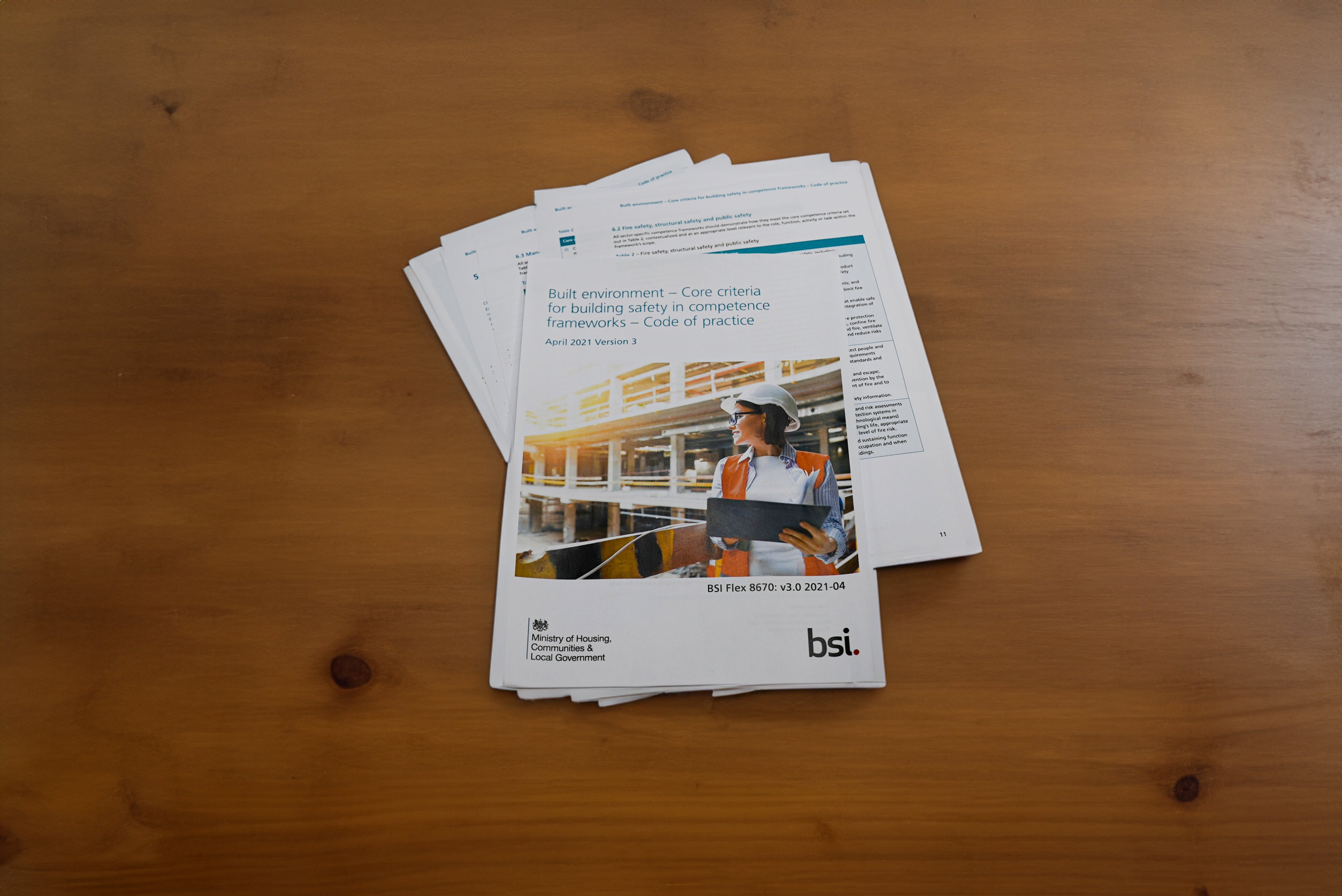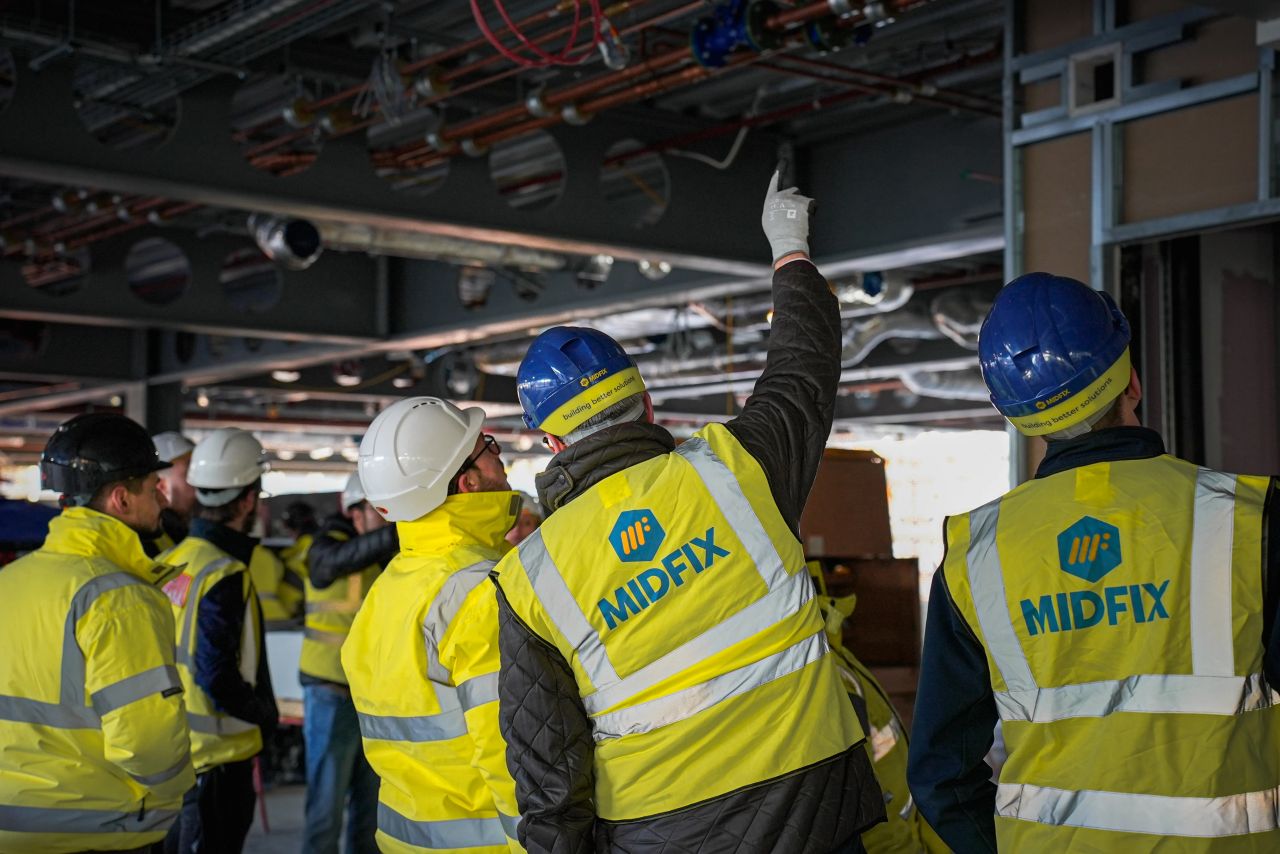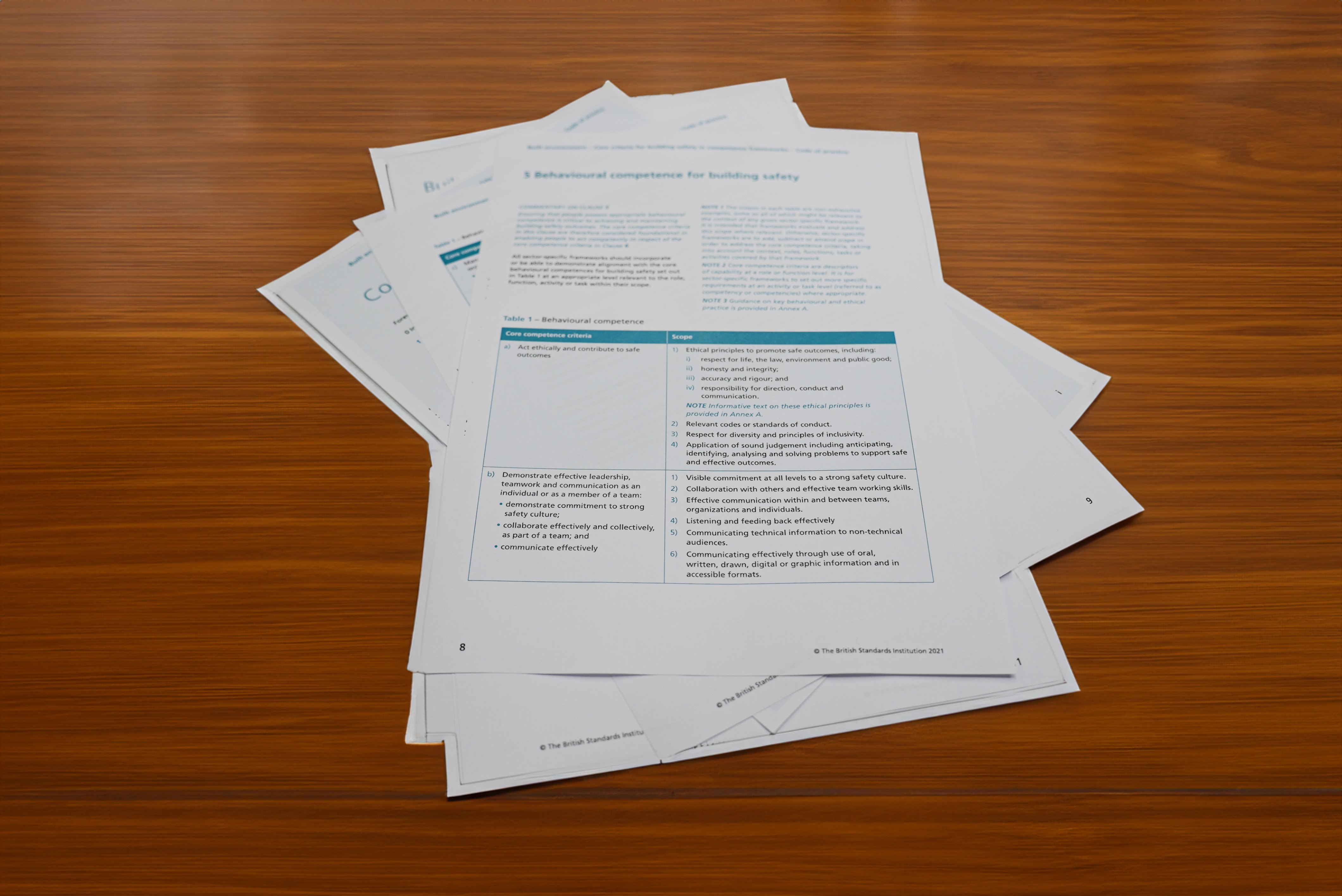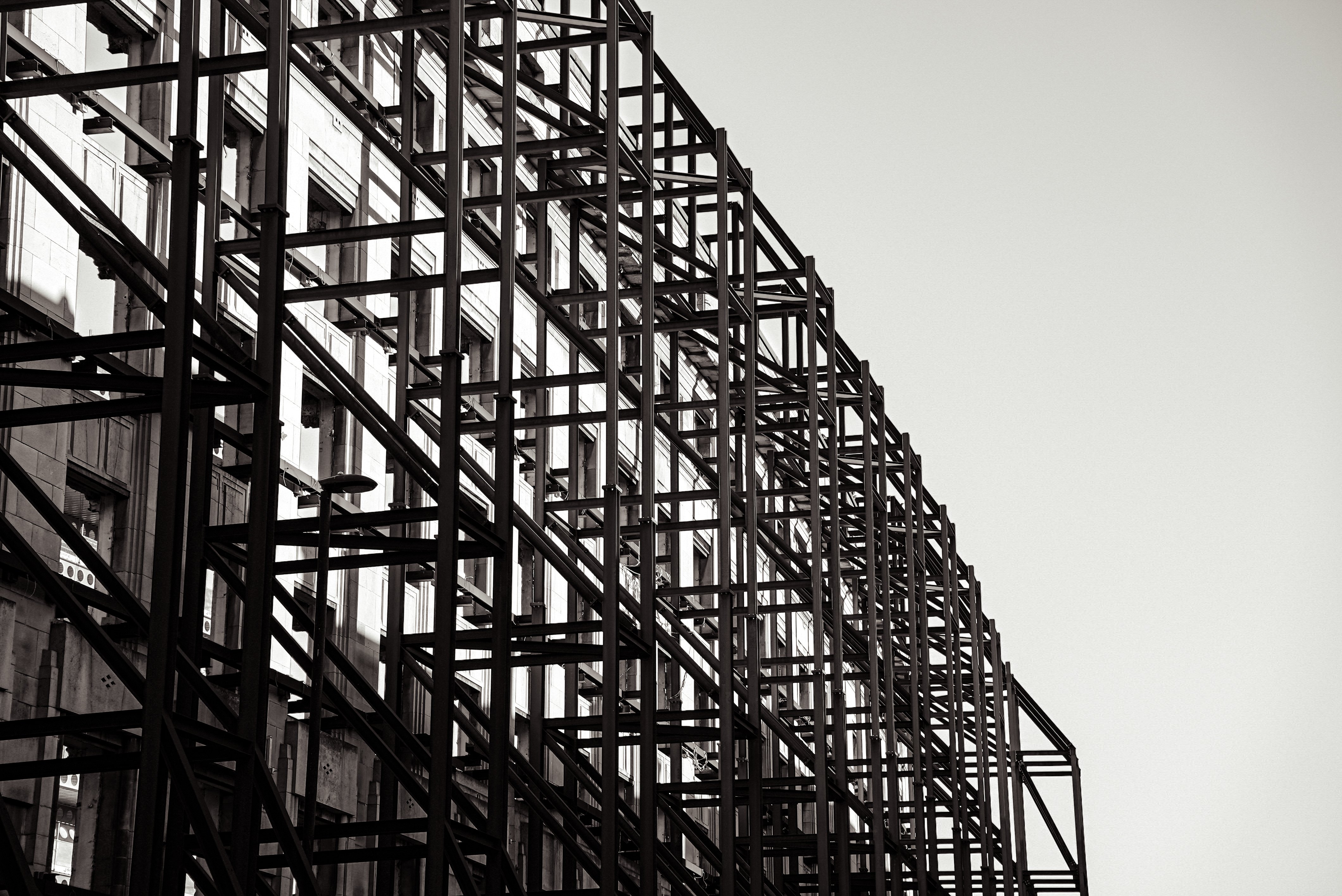When it comes to ensuring the safety and integrity of built environments, BSI Flex 8670 takes centre stage as a comprehensive framework developed to meet the diverse needs of individuals interacting with buildings. Produced by the British Standards Institution (BSI), BSI Flex 8670 sets forth fundamental building safety criteria within competence frameworks, underlining the pivotal role of competence across the entire lifecycle of a building.
At its core, BSI Flex 8670 acknowledges the inherent right of building occupants—residents, workers, and visitors—to a safe and secure environment, placing trust in those tasked with guaranteeing their safety. Fundamental to this trust is the competence of individuals involved in providing services and products throughout a building's life. BSI Flex 8670, therefore, serves as a guiding document.
The overarching objectives of BSI Flex 8670 mirror three essential pillars. Firstly, it endeavours to establish core criteria for building safety competence, spanning the entire lifecycle of a building and encompassing a holistic approach to safety considerations such as fire safety, structural soundness, and public health. Secondly, the document strives to facilitate a consistent and objective development, evaluation, or utilisation of sector-specific competence frameworks by various stakeholders, including certification bodies, regulators, clients, and employers. Finally, BSI Flex 8670 aspires to contribute to a more consistent approach in the development and use of competence frameworks across the built environment, supporting industry-wide reform and minimizing safety risks for consumers and occupants.
- Behavioural Competence for Building Safety
- Fire and Life Safety in Buildings
- Structural Safety in Buildings
- Building Systems and Product Safety
Behavioural Competence for Building Safety
In the construction industry, companies and clients face fierce competition and tight deadlines, often driven by contractual and procurement conditions. These pressures can lead to unsafe practices and unethical behaviours, posing risks to workers and the public, with potential implications for building safety.
To counteract this, fostering a strong safety culture is essential. This culture stems from individual and group values, attitudes, competences, and behaviours that shape an organization's commitment to safety. Achieving a positive safety culture requires integrating effective behavioural competence tailored to specific roles and tasks.
This annex within the PAS 8760 outlines core requirements for behavioural competence and ethical standards. These competences aim to support safe practices and cultivate a positive safety culture across the supply chain and building lifecycle. The goal is to discourage poor conduct and risky behaviours by establishing clear expectations and promoting a culture where safety is prioritized and upheld.

Respect for Life, Law, the Environment, and Public Good:
Individuals involved in the built environment are obligated to be well-versed in applicable laws and regulations. They must prioritize the health and safety of others, identify and address hazards, and ensure that their work aligns with legal, ethical, and justifiable standards. This includes respecting personal information, intellectual property, and contributing to the enhancement of both built and natural environments. Furthermore, individuals should strive to maximize public good while minimizing adverse effects on current and future generations, all while acknowledging the finite availability of natural resources.
Accuracy and rigour:
Building professionals are duty-bound to acquire and apply knowledge and skills responsibly. This includes acting with care, working only within areas of current competence or under competent supervision, and continually updating knowledge and skills. They should contribute to the development of knowledge and skills in others, present information honestly, objectively, and without bias, and identify, evaluate, quantify, mitigate, and manage risks diligently. Misleading practices or allowing others to be misled is strictly prohibited.
Responsibility for Direction, Conduct, and Communication:
Individuals engaged in the built environment must adhere to and promote high standards of personal conduct. Effective communication is crucial, involving clear communication on issues relevant to the built environment's societal impact. This includes contributing to public awareness and understanding of new developments.
Leadership, Teamwork, and Communication:
Building safety requires a behavioural shift to recognize and act on long-term responsibilities. Leadership commitment at all levels, collaboration, and effective communication are essential to fostering a positive safety culture. This includes empowering individuals to address concerns and promoting open communication to identify and manage safety risks.
Fire and Life Safety in Buildings
From a regulatory standpoint, fire safety primarily focuses on safeguarding human lives from death or severe injury caused by fire, rather than preventing property damage.
Characteristics of High-Risk Buildings
The buildings posing the highest risk to life or property damage are not always the most intricate structures but are those where life safety concerns are notably heightened.
- Higher-risk buildings are those where life safety risks are elevated. These include blocks of flats, student accommodations, residential care homes, secure residential institutions (e.g., prisons), and temporary accommodations (e.g., hotels).
- Common characteristics in these buildings include being primarily used for residential purposes, having occupants who are less alert or mobile, and being over 18 meters tall or exceeding six storeys.
- Taller buildings pose greater challenges for evacuation and fire-fighting operations due to longer evacuation times, logistical difficulties for emergency services, and potential construction defects.
- Physical constraints on construction, such as limited access and waste management arrangements, can impact fire safety. Consideration must also be given to fire spread between buildings.
- Buildings where people sleep are considered higher-risk due to longer response times and delayed emergency services intervention. The type of occupants, including vulnerable individuals, also affects life safety risk.
- Familiarity with fire safety procedures is crucial, with permanent residents needing access to information and training, while temporary occupants or occasional users require different safety strategies.
- Having a fire strategy is essential for managing building fire safety, which may include considerations beyond life safety, such as economic loss.
These characteristics influence fire safety strategies, building design, construction, and ongoing management for the safety of occupants and property. It is important to consider these factors when setting competence requirements for fire safety.
Design, specification, and product selection for fire safety
The design of a building plays a crucial role in ensuring fire safety, both for new and existing structures. Here are the key points to clarify this concept:
1. New Building Design:
- In new building design, fire safety is integrated into all aspects, including emergency systems, lighting, alarms, evacuation plans, standby power, and public address systems. Competent designers must work collaboratively to maintain safety standards throughout the building's lifecycle.
- Effective oversight by building control or standards bodies is essential to ensure safe performance.
2. Existing Building Assessment:
While working on existing buildings, it's important to understand how an existing building was originally designed for safe occupancy, how subsequent changes have impacted safety, and how the building must be operated and maintained to remain safe.
3. Design Components:
In the design process, the selection, specification, coordination, and integration of building products are crucial for overall fire safety. This includes evaluating aspects like means of escape, layout, materials, passive and active fire protection systems, human behavior, and operational considerations.
4. Building Regulations and Standards:
Building regulations and standards set the minimum life safety requirements. Alternative fire safety approaches are acceptable but require high levels of competence to assess and integrate into the design. Commonly adopted standards include BS 9991, BS 9999, and BB 100.

5. Competence Requirements:
It is important that consideration is therefore given as to what competence is required for any given discipline, role, activity, or task. Where limits of an individual’s competence is exceeded, it is important that a suitably competent and qualified individual is engaged to contribute in managing the following key aspects of fire safety design:
- ability to comply with or exceed minimum technical requirements for fire safety.
- ability to understand the fire performance of materials, products and systems and make effective choices to promote holistic fire safety in the resultant design.
- ability to coordinate activities with other designers to enable holistic building safety; and
- the need to manage and maintain records and distribute drawings, schedules, specifications, etc. to maintain the golden thread of information through the building lifecycle.
6. Minor Alterations and Refurbishments:
Competence in design is equally critical for minor alterations or major refurbishments of existing buildings. Designers must audit how changes affect safety, considering the original design intent and any interim alterations.
In summary, the design of a building is essential for fire safety, encompassing new construction, existing structures, compliance with regulations, and competence in various design roles to ensure holistic safety throughout the building's lifecycle.
Construction work is a highly complex process that involves numerous suppliers, trades, disciplines, and organizations working together to bring a design to life. This phase includes designers, cost consultants, contractors, subcontractors, and regulators, all of whom must understand their roles in maintaining fire safety standards throughout the project.
Several critical points during the construction process can compromise safety standards, including:
- Inaccurate or inadequate information about fire performance of products and systems.
- Omitted products.
- Incorrectly specified or poorly installed products.
- Substitution of products with lower fire safety performance.
- Use of inadequately tested products or those with a short lifespan.
- Substitution of products without assessing their impact on fire safety.
- Failure to consider components' performance as a system.
- Inadequate commissioning of fire safety systems.
- Poor management of interfaces between trades affecting fire safety.
- Damage to compartmentation during construction or maintenance.
- Cost-cutting without reassessing impacts on fire safety.
- Design work by incompetent designers.
- Re-design or changes without understanding their impact on fire safety.
- Inadequate quality management and oversight.
- Multiple subcontracting levels affecting communication.
- Fragmented supply chains impacting information management.
- Failure to provide temporary fire safety measures.
- Inadequate support for building services.
- Failure to sequence works properly, causing installation problems later.
These risks, alone or combined, can significantly affect overall building safety if not addressed. Effective communication between design and construction phases, clear documentation of design intent, and minimizing changes during construction are essential to mitigate these risks.
Careful consideration is needed to determine the type and level of competence required to address and mitigate these risks, including appointing, checking, and managing competent individuals, understanding construction technology, complying with regulatory requirements, managing fire risks during work, and ensuring proper handover of fire safety information to clients or building owners.
Structural Safety in Buildings
The main goal of structural safety regulations is to prevent structural failures, which can endanger lives both inside and outside buildings. This includes considering the structural design for temporary loads, conditions, and works, especially in occupied buildings. While catastrophic structural failures are rare, they can have severe consequences, including loss of life.
Structural failures encompass various threats, such as localized collapse, instability, falling building parts, and secondary structural elements failing. Serviceability failures like over-deflection can also pose safety risks. Demolition activities can lead to sudden structural failures.
Structural failure can result from events like fire, corrosion, erosion, decay, lack of lateral support, subsidence, weather, and vehicle collisions. Reducing risks involves enhancing structural robustness in new construction and alteration projects, along with recognizing and minimizing the risk of failure from various events.
Competence is crucial in the design, manufacture, erection, and inspection of structural systems to prevent failures. Specialized knowledge is needed, and only competent individuals should be involved in these tasks.
Awareness of how structural aspects relate to overall building safety, including fire safety, is crucial. Unauthorized modifications to buildings can create severe risks, and all modifications should be reviewed and approved by competent professionals.
Key risks associated with structural safety
Structural failures are well-documented, especially when they pose risks to life safety or result in harm or loss of life. These failures are typically categorized into six main causes:
- Insufficient structural robustness or stability, often due to design or fabrication failures.
- Poor construction quality, including non-compliance with design requirements, improper material usage, and subpar workmanship.
- Use of defective materials, sometimes resulting from manufacturing errors or transportation damage.
- Substitution of inferior materials during procurement or construction.
- Failure to account for unlikely but possible real-world conditions in the design, leading to a lack of resilience (e.g., impact, flooding, or explosions).
- Structural failure due to fatigue or corrosion, which can result from overstressing or exposure to environmental factors like water penetration.
Structural characteristics of higher-risk buildings
The document provides guidance on understanding and defining higher-risk buildings, particularly those with characteristics such as increased height, size, occupancy, or usage that pose risks to occupants. These buildings often house large numbers of people regularly, like residential buildings or occasionally, like stadiums.
The structural characteristics of such buildings are influenced by various factors, including location, ground conditions, exposure to weather, proximity to floodplains, expected loads during construction and usage, and construction technologies used.
Designing for extreme conditions, like fire or high wind, is crucial, as it can affect the durability of the building based on the chosen construction technology. Competent designers consider these conditions and associated risks early in the design process.
Additionally, understanding the aging and vulnerability of structural systems, especially in response to factors like fire, water ingress, and corrosion, is vital for building safety. Inspection and maintenance procedures, especially for areas exposed to weather, are integral to good design.
To ensure building safety, minimum levels of competence should be considered in several aspects, including the ability to identify different structural systems, awareness of their performance under conditions like fire and water penetration, understanding the impact of one's role on structural safety, awareness of events that can affect safety, and knowledge of when to seek expert advice or assessments for structural safety maintenance.

Core Competence Criteria:
Contribute to ensuring the safety and stability of buildings through the following:
- Understand the fundamental principles of structural design and construction, including the behavior of structural systems under different loads and during fire incidents.
- Familiarize yourself with building regulations, codes, and standards that pertain to the stability of primary and secondary structures, as well as the various fixings used in construction.
- Comprehend the requirements for upholding structural safety, which may involve tasks such as assessment, inspection, planning, or instruction.
- Know how to respond appropriately to events that could potentially compromise structural safety and be able to secure expert advice from competent specialists when needed.
Design and specification for structural safety
Regulations for building design emphasize adherence to current design codes, particularly focusing on safety factors to ensure redundancy in case of likely events.
Specialist subcontractors should handle various aspects of structural design, including foundations, frames, temporary works, facades, and safety-critical fixtures. In this case, Principal contractors can check that there are clear responsibilities and lines of communication for all those in the supply chain and that subcontractors are suitably competent to undertake design work.
Structural failures often stem from issues with secondary structural elements and fixings, leading to safety risks such as falling objects, incorrect glazing, and inadequately designed fixings. Structural design must also integrate with fire safety strategies, protection measures, corrosion prevention, and service layouts.
The construction phase, whether for new builds, extensions, or maintenance, must prioritize delivering structural solutions aligned with the design. To ensure this:
- Contracting organizations must assess and manage subcontractors' competence in design work and establish clear communication chains for responsibilities.
- Contracting organizations should ensure any structural design changes are approved by a competent structural designer, considering structural and fire safety implications.
- Temporary works must be designed and managed by competent individuals to maintain structural integrity during construction.
Additionally, managing the quality of fabrication, installation, and construction work is crucial. Contracting organizations and their employees should:
- Review and coordinate structural design information developed during construction.
- Review on-site supervision proposals.
- Check materials for quality and suitability to meet structural safety requirements, avoiding substitutions.
- Schedule and manage site inspections at critical phases, such as verifying reinforcement compliance before concrete pouring.
- Conduct quality testing, like weld strength or concrete strength, as needed to meet specifications.
- Refer any variations in structural design or installation changes to structural designers to ensure structural safety.
- Consider independent scrutiny by structural designers or experienced clerks of works to minimize construction errors and ensure competent work.
- Furthermore, accurate records, including photographs, should be maintained during construction for future management purposes by building operators.
Management, operation, maintenance, alteration and demolition
The points highlighted emphasize the importance of ensuring the structural safety and longevity of buildings over a potential lifespan of at least 60 years. This requires the following key considerations:
- Regular Inspection: Periodic inspections are essential to assess the building's structural condition and identify necessary maintenance and remedial work.
- Maintenance and Remedial Work: Addressing issues promptly to prevent damage to the structure is crucial.
- Careful Management of Changes: When making alterations, extensions, or modifications to the building, it's vital to maintain structural integrity over time.
- Retention of Information: Relevant building structural safety information should be retained, possibly through digital systems and building information management.
- Quality in Alterations and Extensions: Significant alterations and extensions should meet the same design and construction standards as new building work.
- Attention to Minor Alterations: Even small changes can lead to structural damage if not done carefully, particularly those affecting fire protection, water tightness, or load-carrying capacity.
- Structural Vulnerabilities: Structures can be vulnerable to corrosion, decay, and fatigue, especially if water enters structural layers.
Building Systems and Product Safety
To ensure comprehensive building safety, it is essential to coordinate various aspects of building design, management, and construction. This involves:
- Carefully selecting construction materials and building systems that are suitable for their intended purpose. These choices should ensure that both individual components and the overall system contribute to maintaining building safety. Consideration should be given to viewing buildings as interconnected systems.
- Recognizing the significance of installation quality in the performance of construction products and building systems. Implementing quality assurance and management processes is necessary to guarantee that installation meets the required standards.
- Establishing requirements for the durability of construction products over time, taking into account the building's intended use and the potential wear and tear it may endure.
- Evaluating the impact of location and contextual factors on the performance and selection of construction products. This includes factors such as proximity to boundaries, compliance with fire resistance and water resistance standards, size, distance, environmental conditions, and geometry.
To further enhance building safety throughout its entire lifecycle, it is crucial to:
- Utilize information from testing, assessment, and maintenance procedures for construction products and building systems. This information should include certifications, classifications, and industry-approved standards. It should inform decisions related to design, specifications, construction, installation, and ongoing management.
- Establish and follow maintenance requirements for construction products and building systems over the building's lifecycle. This involves planning, procuring, monitoring, and managing maintenance activities related to building fabric, fire protection, and life safety systems.
- Plan for the replacement and safe disposal of construction products and building systems at the end of their lifecycle to ensure continued building safety.
- Promptly notify building operators, suppliers, and manufacturers if defects or malfunctions are detected in construction products or building systems that could compromise building safety. This ensures that appropriate actions can be taken to address any issues and maintain the safety of the building.

Knowledge Management and Communication
Ensure the preservation and accessibility of information throughout the building's lifecycle, pertaining to its design, construction, operation, maintenance, and refurbishment, in order to maintain a comprehensive record of data.
- a) Contribute to the documentation, development, collection, organization, and sharing of building-related information to uphold the continuity of this essential information flow.
- b) Securely acquire, record, update, and share building-related data while safeguarding its confidentiality.
1) Establish clear requirements for documenting building safety information at project, premises, and organizational levels.
2) Manage and maintain life safety information, identify essential records, and determine retention methods. This includes managing access to life safety data and preserving the golden thread of information. This encompasses various aspects, such as:
- Digital systems, including building management systems, digital records, building information modelling, and digital engineering standards and systems.
- Safety management systems.
- Safety case.
- Health and safety file.
- Fire risk assessment and emergency plans.
- As-designed/as-built information.
- Building safety strategies.
- Building maintenance information and scheduling.
- Testing and commissioning information, including acceptance reports.
- Inspection reports and any declarations, signoffs, or notices.
- Lifecycle and replacement data.
- HRB records and certificates.
- Data protection and cyber security.
- Management of deleterious materials, including asbestos.
- Information related to temporary works.
- Information related to safe demolition and disposal of building materials.
- Operation manuals.
3) Conduct research to obtain missing information or highlight gaps in data related to building safety, particularly in existing structures.
4) Establish requirements for making information accessible to building occupants, including residents, visitors, and staff.

.jpg?width=451&height=381&name=DSC04794%20copy%20(1).jpg)
